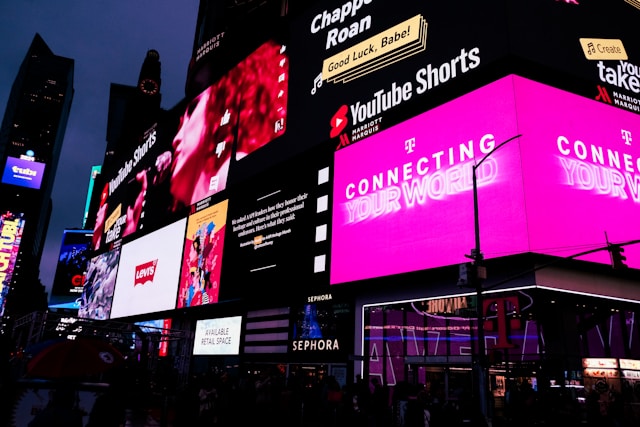Today, marketers no longer confine advertising to banners, billboards, and TV advertisements.
Digital marketing is changing the advertising landscape with innovations that promise to deliver more customer-centric and personalized experiences.
So, what does the future hold? Which digital advertising trends will dominate the future of advertising?
Let’s find out!
This article explores the top six trends that will reshape digital advertising strategies.
6 Key Trends Shaping the Future of Digital Advertising
- The Rise of Artificial Intelligence (AI)
- Voice Search in Advertising
- UGC Advertising
- CTV and OTT Advertising
- DOOH Advertising
- AR and VR in Advertising
So, Which Digital Advertising Trend Will You Follow?
6 Key Trends Shaping the Future of Digital Advertising
Statista predicts that worldwide digital ad spending will hit 870.85 billion dollars by 2027.
This number might go up even more as new digital advertising trends emerge in the market.
1. The Rise of Artificial Intelligence (AI)
AI in the marketing workplace leads the charge in digital advertising.
It applies cutting-edge technologies like machine learning and predictive analysis to analyze massive data sets and craft targeted ad campaigns.
Here are the top three ways AI is making an impact on digital advertising trends:
- Predictive Analytics in Advertising
Predictive analytics gathers data from several sources, like website traffic, customer interactions, and buying patterns, to identify the latest trends.
It then predicts customer requirements and pinpoints which advertising strategies will resonate best with the audience.
It can also optimize ad spending toward audiences who are most likely to engage with the advertisements.
- Personalization in Advertising
A McKinsey survey found that 71% of consumers want brands to provide personalized experiences, and 76% feel frustrated when they see irrelevant ads or receive services that are not tailored to them.
To address this issue, marketers can utilize AI to evaluate customer information and segment customers based on different factors like demographics, age, gender, or preferences.
Additionally, advertisers can use AI to create personalized ad campaigns targeted to unique audiences. Companies can also use smart AI tools like Venngage to generate Flyers and other advertising material. This tool provides easy drag and drop accessibility, a lot of pre-made flyer templates, and customization options so your advertising campaign always hits the mark.
This approach makes sure your ads engage with the right audience to generate maximum return on investment (ROI).
- Chatbots in Advertising
Chatbots are a great way to interact with customers during advertising.
They communicate with users in real time and gather insightful data for future advertising initiatives.
Recent data shows that 67% of companies said that using chatbots increased sales.
Advertisement marketers can implement omnichannel chatbots through platforms like Pepper Cloud AI-powered CRM software that unifies conversations across WhatsApp, email, and social channels for smarter engagement.
This can help them to reach a targeted audience and increase sales.
2. Voice Search in Advertising
Voice search in advertising is gaining traction and might be one of the most popular digital advertising trends as more consumers prefer a hands-free search option.
With the emergence of smart speakers and virtual assistants, such as Alexa, Siri, and Google Assistant, customers are getting habituated to using voice commands for everything from checking weather updates to online shopping.
- How to Optimize Voice Search
Unlike the traditional type-search methods, voice searches are more explanatory, longer, and conversational.
According to Forbes, 90% of users find voice search quicker and more convenient than typing their queries.
Therefore, advertising and sales prospecting services must align their advertisement copies with natural language patterns, SEO best practices (like including long-tail keywords), and direct answers to queries.
This can help gain audiences’ attention, increase engagement, and generate more revenue.
- Audio-Based Ads
Visual marketing format is not the only effective method of advertising.
With the rise of podcast listeners, radio platforms, and affordable music streaming services, audio-based ads have become an effective way to promote your brand.
This allows marketing companies to attract customers while they are busy driving, cooking, listening to music, or in any such activity where gaining visual attention is difficult.
Here’s how Estee Lauder used voice-activated marketing through audio ads:
Company: Estee Lauder
Advertising strategy: The company rolled out a voice-activated digital audio called “Send me a sample” to sell their Advanced Night Repair Serum.
The advertisement encouraged Spotify and Google Home users to say, “Send me a sample” at the end of the commercial to receive a free sample of the product.
Result: This strategy helped the company gather valuable data on consumers who were interested in their products, which proved useful for their future direct-to-consumer sales efforts.
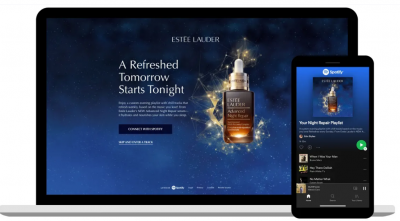
3. UGC Advertising
User-generated content (UGC) ads are one of the hottest digital advertising trends that are becoming increasingly popular.
According to research, UGC ads benefit brands by generating four times more clicks and reducing cost per click by 50% compared to traditional ads.
Instead of the brand, users and influencers, or fans create these advertisements to attract other users’ attention.
UGC advertisements consist of online content like product reviews, feedback, offers, photos, videos, or social media posts. Many brands now utilize an AI UGC Creator to scale authentic content production.
An impressive 79% of consumers report that user-generated content strongly influences their buying decisions.
These results indicate that more consumers trust raw and original content generated by original users or preferred influencers rather than a scripted ad designed by an advertising agency.
Here’s an example from Sephora:
The company uses UGC content from real customers and presents it in their Sephora Community Gallery to attract more customers and improve brand loyalty.
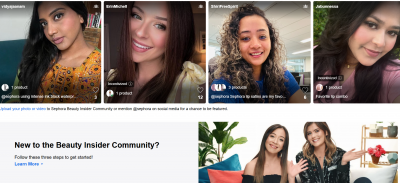
4. CTV and OTT Advertising
Connected television (CTV) refers to internet-connected devices like set-top boxes, gaming consoles, and smart TVs that allow users to stream videos, music, pictures, and other internet-based content.
The CTV digital advertising trend integrates ads into the live streaming environment, like during live TV shows on smart TVs or streaming devices.
These advertisements can be interactive and address unique audience groups.
CTV advertising examples include display banners, pop-up ads, and interactive ads. They are effective in inviting viewer participation via clickable actions like watching a video, voting in a survey, or learning more about a product.
The following image illustrates how marketers use CTV ads in digital advertising:
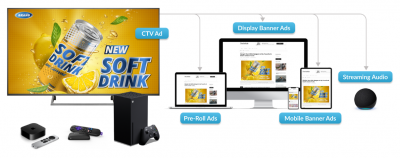
Over-the-top (OTT) ads represent another promising trend in the future of advertising.
Unlike CTV, over-the-top ads are content delivery streaming methods that let users watch on-demand content like movies, TV shows, videos, etc.
Advertising companies directly implement OTT ads within such content.
This strategy effectively drives engagement because users are already watching the content they are interested in, making them more likely to engage with the ads that appear.
Here’s an example showing how a video ad of ‘Central Penn College’ appears while watching another video on an OTT channel.
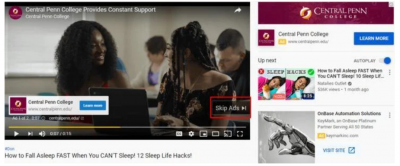
5. DOOH Advertising
Digital out-of-home (DOOH) advertising is redefining the future of advertising by introducing dynamic, attention-grabbing, and engaging content in public settings.
Advertisers utilize billboards, transit screens, and interactive panels to offer location-based digital advertisements.
Brands can deliver these ads in real-time, capturing customers’ attention while they are on the move.
DOOH ad campaigns enable advertising companies to combine the reach of traditional outdoor advertisements with the accuracy of digital advertising.
This helps advertisers connect with customers in a significant way while creating a memorable impression on customers.
The digital advertising trends in DOOH in the future may combine hyper-personalization with data and automation.
This way, marketers may customize advertising depending on audience demographics, time of the day, choices, or purchasing behaviors.
Here’s an excellent example of a DOOH advertisement by Cartier:
Cartier launched a striking 3D billboard ad in Hong Kong, featuring an animated red gift box unwrapped with festival visuals and the message, “Love is all”, capturing holiday shoppers’ attention.
The first 3D Branded Visualization on the Largest 4K Curved LED in Hong Kong
6. AR and VR in Advertising
Interactive and immersive advertising, which uses technology like augmented reality (AR) and virtual reality (VR), is capable of driving significant results in advertising.
AR integrates digital elements like graphics, images, animations, and sounds into the real-world environment.
This enables advertisers to communicate with customers in a creative and fun way.
Marketers and advertisers can enhance user experience by offering virtual product tours and trials.
AR can also help brands upgrade their standard advertisements to attractive and cost-effective ad campaigns, which can increase engagement and sales.
Here’s how Pizza Hut used AR to drive a successful digital advertising campaign:
Company: Pizza Hut
Advertisement strategy: Pizza Hut partnered with the creative development studio tool and GSD&M for an AR ad campaign.
This ad campaign turned pizza boxes into classic PAC-MAN games using a WebAR platform.
Customers could just scan the pizza boxes using their smartphones and play PAC-MAN in augmented reality.
The campaign also included a Super Bowl ad to increase visibility and customer interaction.
Result: Pizza Hut’s AR campaign sold 10.6 million PAC-MAN pizza boxes and earned 741 million impressions, gaining major media coverage across top outlets and TV news.
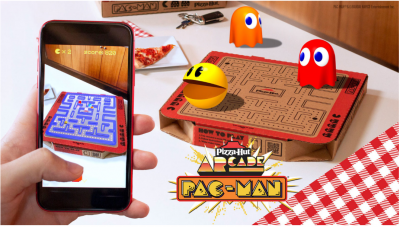
VR advertising enables marketers to present their products to customers in an immersive environment.
By developing virtual showrooms or gamified settings, advertisers motivate buyers to actively explore and interact with their products.
This offers a virtual try-before-you-buy experience to customers and helps in enhancing customer engagement and building trust in the brand.
EyeBuyDirect uses virtual try-on technology, which allows customers to try on glasses online, offering a personalized and immersive shopping experience.
Another key advantage of using VR ads is their ability to overcome language barriers through visual storytelling that connects with audiences worldwide.
Thus, VR advertisements can effectively gain customer attention and boost conversion rates.
Here’s a perfect example of how Adidas leveraged the VR digital advertising trend to attract massive audiences:
Company: Adidas
Advertisement strategy: Adidas launched the ‘The Adidas Football VR Experience’ to engage football fans using immersive VR technology.
Customers visited the selected stores, wore VR headsets and foot sensors, and played virtual football with real kicks.
The visitors also recorded and shared their experiences on social platforms, thereby boosting the campaign’s reach.
Result: The campaign significantly increased foot traffic to Adidas stores. It also generated extensive social media engagement, demonstrating VR’s ability to create unforgettable and shareable brand experiences.
Emissive VR Football Experience
So, Which Digital Advertising Trend Will You Follow?
The latest technological innovations are driving the future of advertising by prioritizing AI-based personalization, effective customer interaction, and data-driven strategies.
As customer requirements continuously evolve, advertisers must adapt quickly to remain relevant.
Embracing trends like voice search, CTV and OTT, dynamic out-of-home, and augmented and virtual reality in advertising can help marketers build strong connections with their audiences while also driving sales.
Want to read more such interesting articles? Visit the Pixpa Blog.
About the Author:
Joy D’Cruz is a content marketing specialist currently working with SaSHunt. Joy has a keen interest in researching topics related to B2B and SaaS. He has created copy for a wide range of marketing and business topics, including social media, email marketing, and career development.
